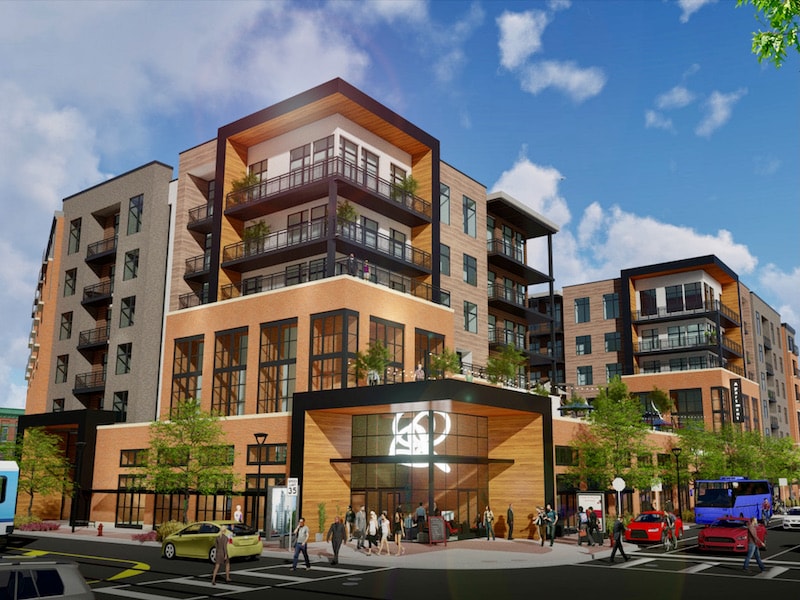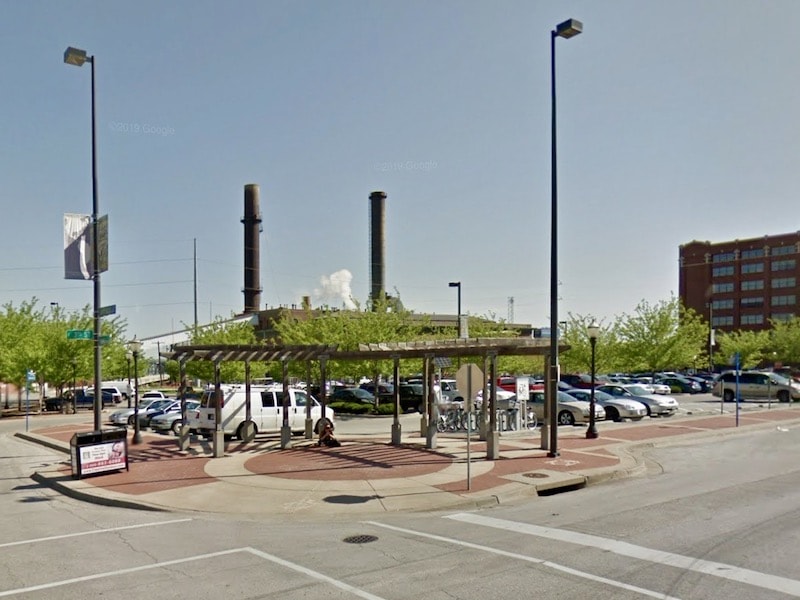Development Agency Ignores City Hall, Rejects $62M River Market Apartment Plan

Published April 22nd, 2022 at 11:30 AM
By Kevin Collison
A $62 million River Market apartment project backed by City Hall had its incentive request rejected by the PIEA board Thursday, another casualty of what critics say has become an increasingly chilly development climate in Kansas City.
The 246-unit development was proposed three years ago for a public parking lot northeast of Third and Grand that’s owned by the city and leased to the KCATA, and had encountered numerous obstacles along the way.
But it was the ongoing debate over how the city uses tax incentives coupled with its stated goal of providing more affordable housing that swayed the board of the Planned Industrial Expansion Authority to turn down the incentive request on a 6-4 vote.
“I’m struggling with paying for more luxury housing in an area that, yes we need it to grow, but I struggle with subsidizing market-rate apartments,” said City Councilman Kevin O’Neill, a board member who voted against the plan.
The project proposed by 3G Development, an entity comprised of CBC Real Estate Group and EPC Real Estate Group, received letters of support from City Manager Brian Platt and the two Council members representing the area, Katheryn Shields and Eric Bunch.

The project was proposed for what’s now a public parking lot northeast of Third and Grand in the River Market. (Image from PIEA presentation)
Bill Crandall, a member of the development group, said it’s too early to say if the project can be revived after being turned down for its request for a 25-year property tax abatement, 10 years at 75 percent, 15 years at 37.5 percent.
“The development team is very disappointed with the outcome,” he said. “We have to reconsider whether to pursue this project or not.”
In their support letters, the city officials referred to the challenges the developer had faced including discovering a 140 year-old sewer beneath the property, 19 percent construction inflation and finally, a late city requirement that removed about 10 percent from the development site for use as a pedestrian and bicycle path.
“It is appreciated that 3G continues their development efforts notwithstanding the pressures put on the market and construction pricing,” Shields wrote.
The developer’s request for a 25-year property tax reduction and a sales tax exemption on construction materials was valued at about $11.6 million by an independent private consultant.
With incentives, the project was expected to yield a 5.1 percent rate of return, according to a PIEA analysis. Without incentives, it would make a 3.6 percent return. The industry standard rate of return is between 7 and 7.5 percent.
The property, which currently pays no taxes, still would have yielded an estimated $9.5 million in new revenues to schools, libraries and other taxing jurisdictions during the 25-year life of the abatement.

The KCATA has been searching for a developer for the Third and Grand property since 2015 and at one time an office deal was proposed for the site. (Rendering by BNIM)
It also would have generated an estimated $3.4 million in sales and earnings tax revenues. The developer also would have paid $2.4 million for the property to be divided between the city and the KCATA.
The plan called for five levels of housing above a 232-stall garage. The development also included 7,500 square-feet of retail space facing Grand Boulevard where the bicycle and pedestrian path was planned.
As part of the project, 3G had agreed to accommodate an internal bus stop, a transfer rest station for RideKC drivers and several parking spaces for the Kansas City Area Transportation Authority.
“They have brought forward what we think is an exciting opportunity and we believe that this project has the ability to accomplish our transit-oriented development (TOD) objectives,” said Brien Starner, president of RideKC Development.
The 3G apartment plan had been submitted before the City Council’s controversial affordable housing ordinance took effect a year ago.
It requires developers receiving incentives to set aside 10 percent of their units for renters earning 70 percent of area median family income (MFI) and 10 percent for those earning 30 percent or less.
The Third and Grand project called for 41 studio units, 172 one-bedroom and 33 two-bedroom. Rents were to range from $988 per month for a 448 square-foot studio to $2,091 for a two-bedroom apartment.
An analysis indicated the studio rents would be affordable for renters earning 68 percent MFI, the one-bedrooms at 78 percent MFI and two-bedrooms at 96 percent MFI.
But while the plan was not subject to the affordable housing ordinance, it was criticized for its lack of affordable housing by opponents on the PIEA board.

The proposed site of the apartment development is currently a public parking lot for the River Market. (Image from Google Maps)
“It feels we have an entire glut of affordable studios and we do need some diversity in housing stock,” said LaDonna Gooden.
The Kansas City School District, which has been a frequent critic of incentive deals in greater downtown and the Main Street corridor, also slammed the proposed 25-year property tax abatement.
“We do take issue with a quarter century of public subsidy for market-rate apartments in a well-developed, wealthy area of town,” said Kathleen Pointer, senior policy strategist for the district.
The rejection of the Third and Grand plan follows the City Council’s decision in January to turn down incentives for another major residential deal, the $100 million, 385-unit project proposed by Mac Properties for Main and Armour.
Like Third and Grand, the Mac deal was caught up in the affordable housing debate although it too, had been proposed before the Council policy had been implemented.
Since the 20 percent affordable set aside policy went into effect, development applications have dropped steeply at City Hall, a fact noted by Shields in her letter supporting the Third and Grand plan.
“In the last year, significantly fewer economic development applications have been processed, despite the availability of funds from lenders and equity investors eager to place their money in local projects,” Shields stated.
“I strongly encourage the PIEA Board to support 3G’s application. In so doing so, the PIEA Board would signal to the local and national real estate community that Kansas City is open for business and would welcome investment in our community.”
Sean O”Byrne, an official with the Downtown Council and the River Market community improvement district, said his organization also has seen a “dramatic slowing” in construction.
“We need this project, we need to see more residents of every income,” O’Byrne said.
“We’re big believers in TOD and it’s all about getting rid of parking lots and maximizing opportunities for housing.”


